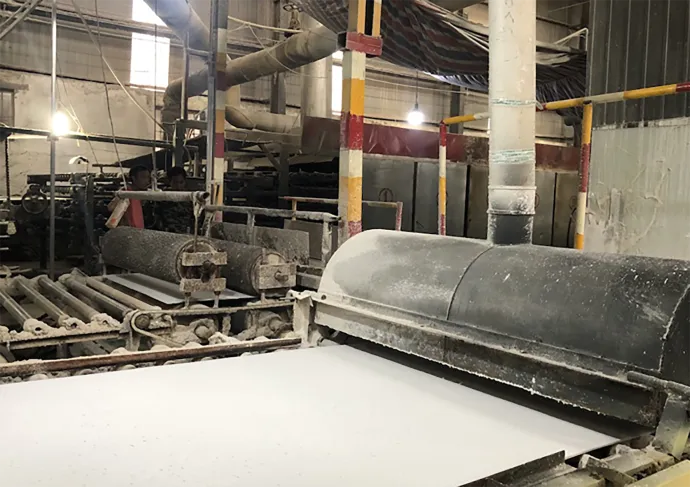- Afrikaans
- Albanian
- Amharic
- Arabic
- Armenian
- Azerbaijani
- Basque
- Belarusian
- Bengali
- Bosnian
- Bulgarian
- Catalan
- Cebuano
- Corsican
- Croatian
- Czech
- Danish
- Dutch
- English
- Esperanto
- Estonian
- French
- German
- Greek
- Hindi
- Indonesian
- irish
- Italian
- Japanese
- Korean
- Lao
- Malay
- Myanmar
- Norwegian
- Norwegian
- Polish
- Portuguese
- Romanian
- Russian
- Serbian
- Spanish
- Swedish
- Thai
- Turkish
- Ukrainian
- Uzbek
- Vietnamese
ส.ค. . 09, 2024 04:20 Back to list
Comparing PVC Ceilings and Gypsum Board for Interior Design Choices and Benefits
Comparing PVC Ceilings and Gypsum Ceilings Which Is Right for You?
When it comes to selecting the right ceiling material for your home or commercial space, two popular options stand out PVC (polyvinyl chloride) ceilings and gypsum ceilings. Each material has its own unique features, advantages, and disadvantages, making them suitable for different applications. In this article, we will explore the differences between PVC ceilings and gypsum ceilings, helping you make an informed decision for your next project.
1. Composition and Durability
PVC ceilings are made from a synthetic polymer that is known for its durability and water resistance. This makes them an excellent choice for areas exposed to moisture, such as bathrooms and kitchens. PVC ceilings are also resistant to mold, mildew, and insects, offering a longer lifespan with minimal maintenance.
On the other hand, gypsum ceilings, composed primarily of gypsum board or plaster, offer a more traditional aesthetic. They are not waterproof and are more susceptible to damage from moisture. In areas with high humidity, gypsum ceilings can sag, warp, or become discolored. While gypsum can be reinforced with paint and coatings, its long-term durability in moist environments is inferior to that of PVC.
2
. Aesthetic AppealWhen it comes to aesthetics, gypsum ceilings have a classic and elegant appearance. They can be intricately designed, painted, or textured to achieve various looks, making them suitable for formal settings such as offices, hotels, and living rooms. The smooth surface of gypsum boards also provides excellent sound insulation, enhancing the acoustic properties of a room.
PVC ceilings, meanwhile, come in a wide variety of colors, patterns, and finishes. They can mimic the look of wood, marble, or metal at a fraction of the cost. This versatility allows homeowners to achieve different decor styles easily. However, some may find the appearance of PVC less sophisticated than gypsum, particularly in upscale environments.
3. Installation Process
pvc ceiling vs gypsum

The installation of PVC ceilings is generally more straightforward and quicker than that of gypsum ceilings. PVC panels are lightweight and can be easily cut and fitted into place, often allowing for a DIY installation. In addition, the installation process avoids the use of water, which can be beneficial in preventing moisture-related issues.
Gypsum ceilings require a more involved installation process, typically necessitating professional help. The boards need to be mounted on a framework, and the joints must be taped and mudded for a finished look. This process can take more time and require specialized skills, which might increase labor costs.
4. Cost Considerations
When comparing costs, PVC ceilings are often more cost-effective than gypsum ceilings. The materials themselves tend to be less expensive, and the ease of installation can lead to savings on labor. PVC is also less prone to damage over time, which can reduce maintenance costs.
In contrast, gypsum ceilings may require a higher initial investment due to material and installation complexities. However, they might offer long-term value for specific applications, particularly in settings where aesthetics and acoustics are essential.
Conclusion
In conclusion, the choice between PVC ceilings and gypsum ceilings largely boils down to your specific needs and preferences. If you are looking for a moisture-resistant, low-maintenance, and cost-effective ceiling option, PVC ceilings are a fantastic choice. However, if you prioritize aesthetic appeal and acoustic performance, and are willing to invest more in installation and materials, gypsum ceilings may be the way to go.
Ultimately, understanding the strengths and weaknesses of each material will enable you to make the best decision for your space, ensuring that it meets your functional, aesthetic, and budgetary requirements.
-
Transform Interiors with PVC Gypsum Ceiling: A Stylish, Durable, and Moisture-Resistant SolutionNewsMay.19,2025
-
The Smart Interior Upgrade: Discover the Durability and Versatility of Gypsum Ceiling Access Panel SolutionsNewsMay.19,2025
-
The Smart Choice for Interior Design: Discover the Value of PVC Gypsum Ceiling SolutionsNewsMay.19,2025
-
Mineral Fiber Ceiling Tiles: The Smart Blend of Performance and AestheticsNewsMay.19,2025
-
Mineral Fiber Ceiling Tiles: The Superior Choice Over Gypsum for Sound and Fire SafetyNewsMay.19,2025
-
Mineral Fiber Ceiling Tiles: Eco-Friendly Strength and Style for Every CeilingNewsMay.19,2025







